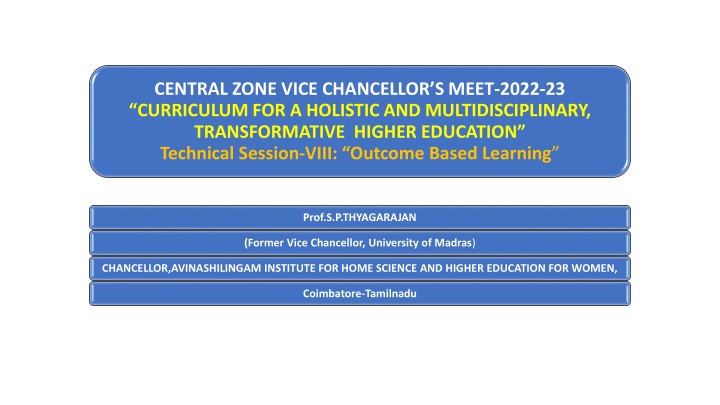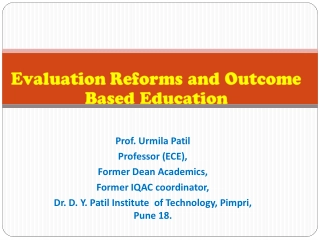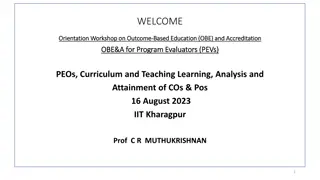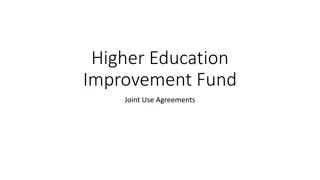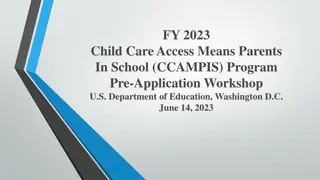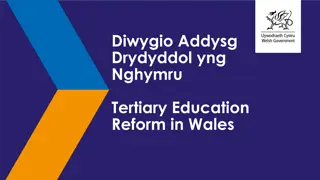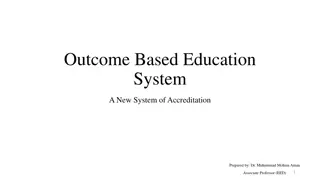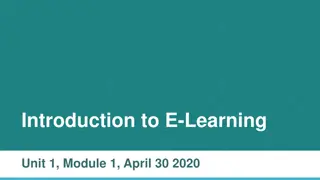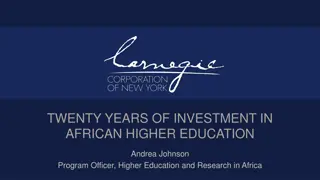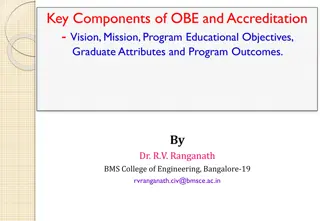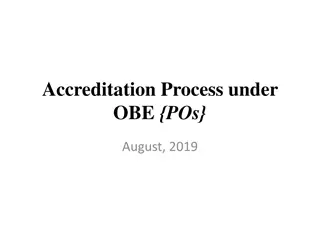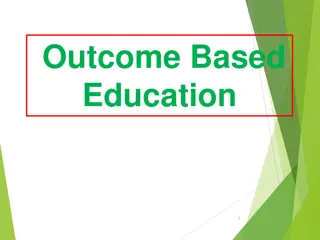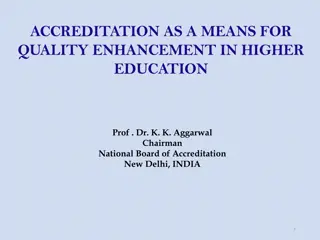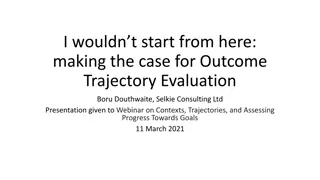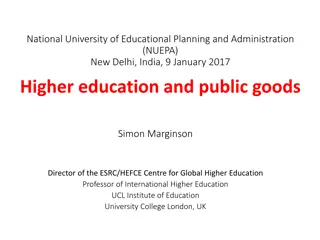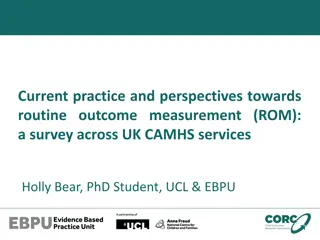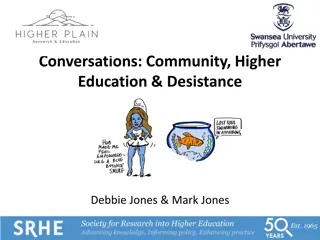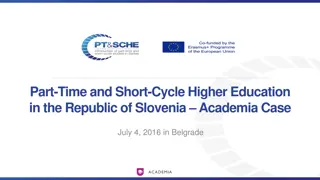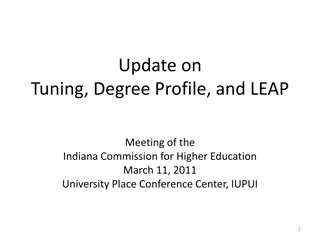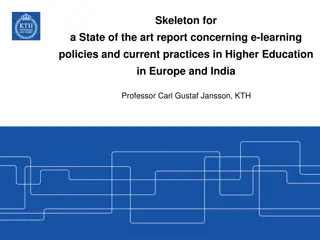Outcome Based Learning in Transformative Higher Education
Explore the implementation of Outcome Based Learning in higher education, focusing on competencies, course outcomes, programme objectives, and educational goals for holistic development. An in-depth technical session featuring prominent educators highlights the importance of aligning learning outcomes with societal demands and achieving educational success through acquired abilities. Embrace a multidisciplinary approach to knowledge acquisition for a transformative educational experience.
Download Presentation

Please find below an Image/Link to download the presentation.
The content on the website is provided AS IS for your information and personal use only. It may not be sold, licensed, or shared on other websites without obtaining consent from the author.If you encounter any issues during the download, it is possible that the publisher has removed the file from their server.
You are allowed to download the files provided on this website for personal or commercial use, subject to the condition that they are used lawfully. All files are the property of their respective owners.
The content on the website is provided AS IS for your information and personal use only. It may not be sold, licensed, or shared on other websites without obtaining consent from the author.
E N D
Presentation Transcript
CENTRAL ZONE VICE CHANCELLORS MEET-2022-23 CURRICULUM FOR A HOLISTIC AND MULTIDISCIPLINARY, TRANSFORMATIVE HIGHER EDUCATION Technical Session-VIII: Outcome Based Learning Prof.S.P.THYAGARAJAN (Former Vice Chancellor, University of Madras) CHANCELLOR,AVINASHILINGAM INSTITUTE FOR HOME SCIENCE AND HIGHER EDUCATION FOR WOMEN, Coimbatore-Tamilnadu
TECHNICAL SESSION III: Outcome Based Learning Prof. S.P. Thyagarajan Chancellor, Avinashilingam University & Former VC, Madras University (Chairman) OBE/OBL-Introduction and Basics (5minutes) Dr. K. P. Mohanan Co-Founder, ThinQ Curricular framework for Higher Order Cognition (10 minutes) Dr. Basuthkar J Rao Assessment Methodologies for Outcome Based Learning (10 minutes) Vice Chancellor, University of Hyderabad Dr. Alok Kumar Chakrawal Vice Chancellor, Guru Ghasidas Vishwavidyalaya Outcome -Based Learning as per NEP-2020 (10 minutes) Floor Participation & Discussion wth panelists Summary & Recommendations by Chairman (10 minutes) (45 minutes)
Competencies/ abilities Quality of Knowledge Outcome OBE/ OBL Qualification Degree Quantity of Knowledge Output
Competencies It is defined as the ability acquired by the students to meet educational demands of society. It is to carry out a task successfully based on defined assessments It has cognitive and non-cognitive dimensions Outcome qualification vs competencies Acquisition of knowledge vs utilization of knowledge Knowledge synergy with skill inculcation
Important aspects of Learning Outcome Based Education 1. Course is defined as a theory, practical or theory cum practical subject studied in a semester. For Eg. Engineering Mathematics 2. Course Outcome (CO) Course outcomes are statements that describe significant and essential learning that learners have achieved, and can reliably demonstrate at the end of a course. Generally three or more course outcomes may be specified for each course based on its weightage. 3. Programme is defined as the specialization or discipline of a Degree. It is the interconnected arrangement of courses, co-curricular and extracurricular activities to accomplish predetermined objectives leading to the awarding of a degree. For Example: B.Sc., Home Science
Important aspects of the Outcome Based Education contd.. 4. Programme Outcomes (POs) Program outcomes are narrower statements that describe what students are expected to be able to do by the time of graduation. POs are expected to be aligned closely with Graduate Attributes. 5. Program Educational Objectives (PEOs) The Programme Educational Objectives of a program are the statements that describe the expected achievements of graduates in their career, and also in particular, what the graduates are expected to perform and achieve during the first few years after graduation. 6. Programme Specific Outcomes (PSO) Programme Specific Outcomes are what the students should be able to do at the time of graduation with reference to a specific discipline. Usually there are two to four PSOs for a programme. 7. Graduate Attributes (GA): The graduate attributes, 12 in numbers are exemplars of the attributes expected of a graduate from an accredited programme.
TODAYS CURRICULAR FRAMEWORK Program-Degree; Courses- papers Modular and unitized Learning Objectives Unitized syllabi Further reading as Text Books, References, e- Resources; Learning outcomes and outcome-based assessments.
REVISED BLOOMS TAXONOMY Creating Evaluating Analyzing Applying Understanding Remembering
According to revised Blooms taxonomy, the levels in cognitive domain are as follows: Level Descriptor Level of attainment 1 Remembering Recalling from memory of previously learned material 2 Understanding Explaining ideas or concepts 3 Applying Using information in another familiar situation 4 Analysing Breaking information into parts to explore understandings and relationships 5 Evaluating Justifying a decision or course of action 6 Creating Generating new ideas, products or new ways of viewing things/developments
Learning Levels Assessed through Creating Innovative Projects Mini Project Minor Project Capstone Project (ProjBL) Assignments(PBL) Evaluating Analyzing Applying Fixed hour examinations (CIE & SEE) Understanding Remembering Assessment methods for different Bloom s cognitive levels
Competencies to be Attained CA Program outcomes PO Performance Indicators PI Assessment PI 1.1.1 CIE and SEE questions, project / lab, Competency 1.1 PI 1.1.2 PI 1.1.3 assignment rubrics PI 1.2.1 Competency 1.2 Program Outcome -1 PI 1.2.2 PI 1.3.1 Competency 1.3 PI 1.3.2 PI 1.3.3
Methods of Assessment
Assessment METHODS What are assessment methods? Assessment methods are the strategies, techniques, tools and instruments for collecting information to determine the extent to which students demonstrate desired learning outcomes. Several methods should be used to assess student learning outcomes (SLO)
What are direct and indirect methods of assessment? Direct methods of assessment ask students to demonstrate their learning methods ask students to reflect on their learning. while indirect Tests, essays, presentations, etc. are generally direct methods of assessment. Indirect methods include surveys and interviews etc.,
Methods should be MATURE Matches: Is aligned with the outcome to be measured Appropriate: Choose appropriate method Targets: Indicates desired level of performance Useful: Will provide you with useful and useable information; methods help identify what is already effective and what can be improved Reliable: Based on tested, known methods and yields consistent results over time. Effective and Efficient: Each approach accurately and concisely measures the http://oeas.ucf.edu/doc/adm_assess_handbook.pdf Adapted from outcome.
Learning Planner COMPETENCY DASHBOARD INDIRECT RUBRICS Key area Critical & Creative Thinking Competency Multiple approach of problem solving concepts % Complete 45% 68% Next Assignment search marketing plan Business Essentials Quantitative Skills Communication Skills Marketing Terminology and To distinguish facts from opinion 25% Analyze an advertisement Convey info through ICT 70% Develop a budget or Presentation by ICT Conduct web Create a Key Competency Snapshot Upcoming Assignments - Opportunities
Revised BLOOMs Taxonomy CREATING EVALUATING ANALYSING APPLYING UNDERSTANDING REMEMBERING
Cognitive Domain Level 1 Domain Knowledge Description It is the ability to remember the previously learned material / information It is the ability to grasp the meaning of the material 2 3 Comprehension Application oriented Analysis It is the ability to use learned material in new and concrete situations It is the ability to break down material / concept into it s component parts / subsections so that it s organizational structure may be understood 4 It is the ability to put parts/subsections together to form a new whole material / idea / concept / information. 5 Synthesis It is the ability to judge the value of material / concept / statement / creative material / research report for a given purpose 6 Evaluation
Direct vs. Indirect
Direct Methods Locally developed tests/test questions Rubrics for evaluating: Essays/Papers Labwork Exam questions Capstone projects Exhibits Performances/Presentations Portfolios of student work Comprehensive exams Standardized tests Certificate exams
Indirect Methods Surveys Student Alumni Employer Exit interviews Focus groups Job placement rates Course evaluations
Using Rubrics to Assess SLOs What is a rubric? A scoring guide composed of the things you are looking for guidelines for evaluating each of those things (Suskie) A kind of scorecard that breaks down a written or demonstrated assignment into manageable, observable pieces. (UVA) Types of rubric Holistic A single score for overall performance Analytic Grading is broken down into specific criteria with levels of performance provided Checklist Indicates if a scoring criterion is present, as opposed to providing a description of performance
Using Rubrics to Assess SLOs Why use a rubric? If the assignment requires an answer more complicated than one that could be corrected with an answer key. When evaluated, which require more than a right or wrong answer. complex products or behaviors are being Rubrics are often used to assess how well students perform a task (speaking, writing, performing, etc.) as opposed to whether an answer is right or wrong quality continuum from exceptional to not meeting expectations
Steps to Using Rubrics to Assess SLOs Identify SLO Choose student work to be used for assessment Specify criteria for successful performance on specific SLO(s) Include various performance levels from poorest to best Assign ratings to performance levels and descriptors for each criterion Devise a scoring procedure/process for collecting data using a sample vs. using all submitted work Rubric is used by all instructors vs. small group apply rubric to work Determine criteria for success Data is reviewed and discussed Efforts to improve student learning are put in place Adapted from
Using Grading Component for Assessment SLO: Effectively synthesize past research Assignment: Report Components of Report Grade for the Course: Effective introduction (10%) Literature review (20%) Appropriate thesis statement (20%) Evidence supports hypothesis (20%) Conclusion connects to body of report (20%) Language/formatting (10%)
Components of Report Grade SLO: Effectively synthesize past research Average: 12.57 (of 20) = 62.85% Criteria for success: The overall average for the grading component devoted to synthesizing past research must be at least 15 (of 20) = 75% Whether Level of achievement met? No
General Guidelines for Choosing Methods of Assessment
UGC-Commission,May,2018 Improved graduate outcomes to at least 50% of graduates to access employment/self employment and rest higher education; At least 2/3rdof students to engage in socially productive activities and/or in industry during their study; Graduates acquire professional knowledge, soft skills entrepreneurship skills and human values/ethics; Professional development of 100% of teachers in terms of domain knowledge and pedagogical competencies
Intervention Strategies Intervention program for students; Outcome-based curriculum framework and periodic revision of curriculum Use of ICT based learning tools; Induction and Regular refresher courses for teachers; Promoting quality research by faculty; Examination reforms; Teaching soft skills to students; Engagement of HEIs in socially productive activities and with Industry.
